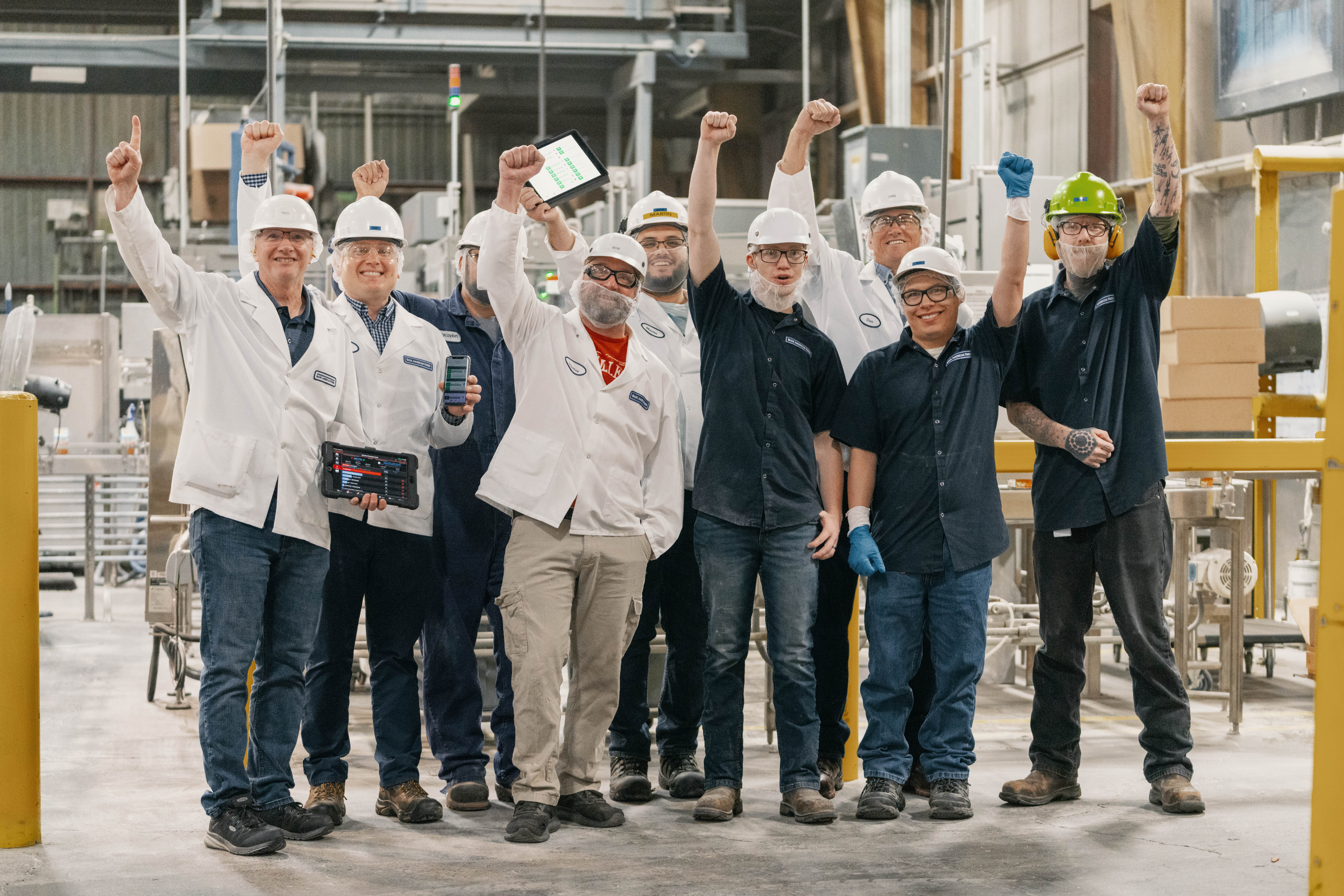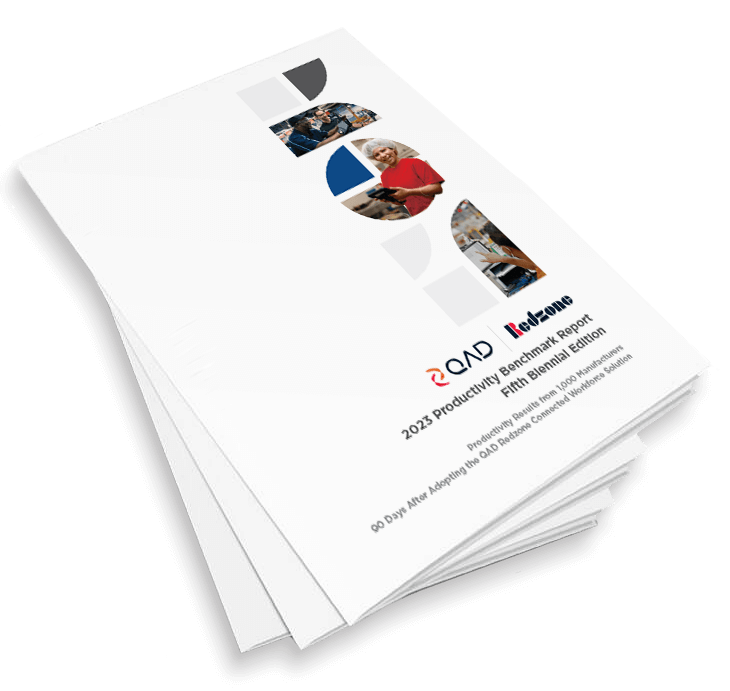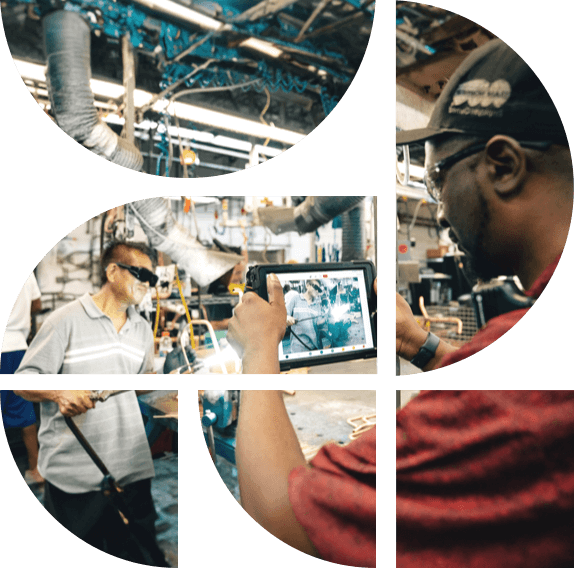Press Release: QAD Redzone is Front Runner in LNS Research Connected Frontline Workforce Applications Solution Selection Matrix Read Now
Ken Fisher
April 13, 2023

How engaged are your frontline workers? The answer may surprise you.
According to a 2020 Global Workday report, while 34% of manufacturing employees feel engaged, a disconcerting 38% feel disengaged and an additional 27% feel actively disengaged. The less engaged employees feel, the more likely they are to seek opportunities elsewhere — a serious concern given the manufacturing industry’s ongoing labor shortage.
A recent report from Innovation Research Interchange, Improving Workforce Morale and Motivation, offers strategies manufacturers and other industry companies can put to use. Companies that deploy connected workforce solutions can amplify these gains by creating a dynamic flywheel of engagement and process improvement.
Given the stakes, it’s imperative that manufacturing companies invest in frontline engagement, not only to keep up with the demands of doing business but also to meaningfully improve workers’ experiences.
The term “employee engagement” was coined by William Kahn, a professor of organizational behavior at Boston University, in the 1990s.
Kahn theorized that in order to feel fully engaged — that is, to feel a mental and an emotional connection to not only the job itself but also to their company’s culture and organizational mission — employees require three things:
According to Kahn, when these conditions are met, manufacturing employees embody the traits of strong and engaged manufacturing professionals. The end result is one (or more!) of the three dimensions of engagement:
Physical engagement translates to manufacturing employees feeling well-supported by both management and their colleagues. This support fosters a healthy attitude toward work, and employees become mentally and physically engaged in their day-to-day responsibilities. For example, empowered manufacturing employees actively participate in continuous improvement initiatives, collaborate with their team to enhance efficiency, and take pride in contributing to the smooth operation of the production floor.
Manufacturing professionals excel when they understand and believe in their company’s organizational goals. In this context, cognitive engagement means employees are focused on their work, able to tune out distractions, and fully comprehend what it takes to excel in their roles. For instance, a cognitively engaged manufacturing employee not only knows the importance of meeting production targets but also comprehends the broader organizational strategy, aligning their efforts with the overall success of the company.
In the manufacturing environment, emotional engagement is reflected in employees feeling valued, appreciated, and connected to a meaningful contribution toward a shared goal. This emotional investment leads to higher job satisfaction and helps create a positive workplace environment. For instance, manufacturing professionals who feel emotionally engaged are more likely to actively participate in team-building activities, support their colleagues, and take pride in the collective achievements of the production team.
By aligning with these dimensions of engagement within the manufacturing context, you can cultivate a workforce that not only excels in technical skills but also embodies the characteristics of strong, engaged manufacturing employees.
It should, of course, be the aim of every manufacturing company to create a happy and healthy workplace environment and to provide the best possible experience to its frontline workers. Improving employee engagement is a key part of this. But in addition to the human element, frontline employee engagement also has tangible business benefits:
In addition to the business benefits listed above, shopfloor employee engagement can also:
In order to improve frontline employee engagement, manufacturing companies must first understand the underlying causes behind disengagement. Employees may feel disengaged due to:
1. A Lack of Purpose or Meaning: Gartner recently coined the term the “Great Reflection” — a clever play on the “Great Resignation” — to make sense of why employees leave good, stable jobs. The reality is that the COVID-19 pandemic prompted a change in how people view their current jobs, with a growing number of people looking for work that aligns more closely with their personal values or that makes them feel fulfilled.
2. A Lack of Communication: In manufacturing, production moves fast, which means frontline workers need access to the most up-to-date information and a way to communicate with their peers and managers in real time. Without clear guidance or communication, workers aren’t set up to succeed or inspired to collaborate.
3. A Lack of Job Growth: Doing the same job day in and day out, with no opportunity for advancement or rewarding workplace challenges is a recipe for boredom, dissatisfaction and disengagement.
4. A Lack of Respect & Recognition: Frontline workers are the lifeblood of any manufacturing company, responsible for keeping production moving. As such, they deserve respect and recognition for their hard work — and are likely to become disengaged and change jobs if they don’t receive it.
In fact, according to one survey, 46% of Americans have reported leaving a job because they felt unsupported. The inverse is also true: 65% of respondents said that they would work harder if they felt like their contributions were noticed by management.
5. A Lack of Feedback: In addition to recognition, frontline workers also seek qualitative feedback on their performance so that they can continue to grow in their careers. Without a strong feedback loop or an understanding of how their role relates to organizational goals, employees can start to feel demotivated and disengaged.
6. Poor Management & Leadership: For many frontline workers, having the right manager can make all the difference in their overall experience. Without a management and leadership team that’s invested in their continued growth and success — beyond initial onboarding and training — shopfloor employees may feel less engaged in their work. Other contributing factors to poor management and leadership include micromanaging and a lack of transparency into business decisions.
7. A Lack of Training: Without proper training, frontline workers may struggle to complete certain tasks, understand organizational goals and meet performance expectations. To prevent this from happening, it’s important that manufacturing companies provide the resources to support effective onboarding and training and foster a culture of continuous learning and improvement.
8. A Lack of Resources: Speaking of resources, a growing number of frontline workers now look to their employers to utilize technology to drive shopfloor communication, collaboration and technology. Without these resources to support them, employees may struggle to meet the expectations of an increasingly digitized manufacturing landscape and seek out workplaces that enable them to develop their technological skills.
9. A Lack of Flexibility: Shopfloor employees may not be able to work from home the same way office workers do, but that doesn’t mean manufacturing managers should deprive them of flexible scheduling. In fact, flexible scheduling is proven to improve frontline workers’ work-life balance and overall morale, both of which have a direct impact on engagement.
Pave the Way for Gen Z Workers with Flexible Scheduling [& More] >>
10. Excessive Workload: Asking frontline workers to do more work without adjusting their schedules to accommodate it can cause undue stress and quickly lead to low productivity, burnout, absenteeism and other problems commonly associated with disengagement.
11. Poor Utilization: Frontline workers’ time is valuable and should be treated as such. For this reason, employees may find themselves frustrated when asked to do menial, paper-based tasks rather than focus on work that is more challenging and engaging. And poor utilization doesn’t just impact employees: It can also lead to equipment idle time, which threatens manufacturers’ overall equipment effectiveness (OEE).
Though these obstacles to shopfloor employee engagement may seem intimidating, they’re entirely solvable. To increase frontline engagement, manufacturing companies should:
1. Give employees a voice — and actually listen to what they have to say. From giving employees the opportunity to share both ideas and issues with company leadership to being totally transparent about how business decisions are made, maintaining open lines of communication and fostering a culture of collaboration in which workers are seen, heard and understood is critical to frontline engagement.
“With QAD Redzone, when I go out on the floor, I already have the information I need about the challenges our teams are experiencing. I can communicate with them anywhere and anytime, at my desk, on the floor, and at home, using the mobile app,” says Meg Post, CEO, Haviland Enterprises, Inc.
2. Recognize employees for their contributions. Everyone likes to be told when they’re doing a good job — and, according to a 2021 study from The Manufacturing Institute’s Center for Manufacturing Research, employees who feel valued are more than four times as likely to report high levels of engagement than those who do not. Create a culture of celebration: QAD Redzone provides an easy way for managers to recognize good ideas or when employees out-deliver.
When determining how best to celebrate frontline workers for their achievements, go straight to the source: Managers should ask employees directly how they prefer to be recognized — be it publicly, privately, peer-to-peer or manager-to-employee — and plan accordingly.
Jason Hetcher, a production team member of ASR Group Yonkers, a sugar refinery, has contributed winning ideas, including rearranging work steps to increase efficiency and adding a valve to the dust collector to prevent spillage when it is emptied. This one fix saved an hour of cleanup and line downtime per line.
3. Treat people with respect and promote inclusivity. This best practice ties directly back to Kahn’s condition of safety. When employees feel safe and comfortable being their full selves in the workplace and as though they belong, they’re more likely to be engaged in their work. Not only that, but when frontline workers feel as though they’re treated fairly and with dignity, they’re more likely to reciprocate that respect to management and leadership.
4. Be flexible whenever possible. Whether it’s offering flexible hours, letting workers swap shifts or working a compressed schedule, there are any number of ways manufacturing companies can deliver the flexibility their teams desire without compromising on productivity or quality.
5. Help employees understand how their work connects to company goals. Frontline workers can sometimes feel as though they live in an entirely different world than senior leaders and as though decisions that affect employees at all levels of the organization are made in a vacuum. The best way to solve for this problem is by being as transparent as possible: Have managers explain how and why certain decisions are made and draw a direct correlation between the frontline’s contributions and company goals.
6. Implement training, career development and continuous improvement programs. Proper training is just the beginning: Manufacturing managers need to make sure that shopfloor employees fully understand their roles and performance expectations and have all the support they need to succeed, regardless of whether they’ve been on the job for one day or several years.
Leadership should also create advancement opportunities for longtime employees who consistently go above and beyond, as well as continuous improvement programs that enable frontline workers to develop new skills and take on new challenges.
Frontline workers want to progress their careers. More than 70% have applied for promotions. QAD Redzone surfaces opportunities and creates them. Workers can use digital skills matrices to develop skills their companies need and lead initiatives, such as deploying the QAD Redzone Productivity, Compliance, Reliability, and Learning modules.
Managers can use QAD Redzone to help identify the most engaged and innovative staff. Promoting from within also provides teams with role models, motivation, and assurance that there is a place for them at the company long-term.
Jessica Hernandez, who started as a temporary worker at Dot’s Homestyle Pretzels, a leading snack company, is now a training lead. She has created hundreds of training documents, PMs, standards, and plays in QAD Redzone, helping her teammates learn equipment and processes and solve common problems. As just one example, Dot’s was building displays and sleeves incorrectly for large retail customers, creating hours of rework and costing thousands of dollars. Now, the team has 80 standards to guide their work.
7. Streamline shopfloor communications. Using mobile technology, manufacturing companies can make it easy for workers to access the information they need to do their jobs, communicate and collaborate with their peers and receive real-time updates from management and leadership. With faster, more effective shopfloor communications, workers are empowered to excel, enhancing productivity, efficiency and frontline engagement.
Not everyone is a natural communicator. QAD Redzone helps by providing structure to daily huddles and making communication informal – over chats and updates on the app.
8. Foster meaningful relationships across teams. Frontline engagement goes beyond helping workers feel more connected to their jobs and their company — it also entails making workers feel more connected to one another. Whether it’s providing opportunities for employees to get to know each other outside of work, such as team lunches and special events, or utilizing frontline collaboration software so workers can solve problems as a team, there are many ways for manufacturing companies to encourage interpersonal relationships and create a sense of community.
Nissin Foods USA, which makes Japanese noodles for the US market, deployed QAD Redzone to troubleshoot bottlenecks across multiple production lines. Using overall equipment effectiveness (OEE) to evaluate production across lines consistently, hiring and cross-training staff, and making process fixes, Nissin Foods increased production capacity by 30% without making Capex investments.
Implementing the best practices listed above is an important step in the right direction for any manufacturing company — but how can managers and senior leaders determine whether their frontline engagement efforts are effective?
There are a few ways to gauge employee engagement in manufacturing, including:
To get the most accurate read on frontline engagement, manufacturing companies should look to implement all of these measurement strategies.
At QAD Redzone, we believe that happy, engaged employees are productive employees, which is why we’ve developed solutions that help manufacturing companies optimize frontline engagement.
We recently helped one of our clients improve production visibility, automate key processes to eliminate time-consuming paperwork and take worker engagement to the next level. The end result? A 50% reduction in changeovers, a 20-point OEE uplift, a 57% reduction in giveaway and a 20% production increase in units per hour.
These are the kind of business results you can expect to see by partnering with QAD Redzone to increase shopfloor employee engagement. Contact us today to learn more about our Connected Workforce Solution.
Last Updated 03/08/2024
Download our inaugural Frontline Workforce Engagement Study to see which strategies and techniques worked for real QAD Redzone customers.
Ken Fisher Ken Fisher, SVP Product, Marketing, and Solutions at Redzone, is a seasoned professional with over 20 years of experience in manufacturing operations and lean transformation. He has a deep understanding of industry challenges and is dedicated to recognizing the value of frontline workers in manufacturers' success. Ken leads a team at Redzone that enhances current products, develops new solutions, and works with factories to design digital production systems that achieve operational goals. He also served as a Continuous Improvement Coach, implementing Redzone in food processing facilities. Notably, Ken spoke at the Food Safety Summit in 2019. He holds a B.S. in Industrial Engineering from the University of South Florida and an M.B.A. from the University of Florida.
1,000 Factories’ Productivity Data: The Largest Dataset of Its Kind ...

Contact us and let's begin empowering your frontline and growing your bottomline.
